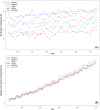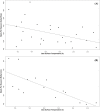Climate Impacts on Sea Turtle Breeding Phenology in Greece and Associated Foraging Habitats in the Wider Mediterranean Region
- PMID: 27332550
- PMCID: PMC4917093
- DOI: 10.1371/journal.pone.0157170
Climate Impacts on Sea Turtle Breeding Phenology in Greece and Associated Foraging Habitats in the Wider Mediterranean Region
Abstract
Sea turtles are vulnerable to climate change impacts in both their terrestrial (nesting beach) and oceanic habitats. From 1982 to 2012, air and sea surface temperatures at major high use foraging and nesting regions (n = 5) of loggerhead turtles (Caretta caretta) nesting in Greece have steadily increased. Here, we update the established relationships between sea surface temperature and nesting data from Zakynthos (latitude: 37.7°N), a major nesting beach, while also expanding these analyses to include precipitation and air temperature and additional nesting data from two other key beaches in Greece: Kyparissia Bay (latitude: 37.3°N) and Rethymno, Crete (latitude: 35.4°N). We confirmed that nesting phenology at Zakynthos has continued to be impacted by breeding season temperature; however, temperature has no consistent relationship with nest numbers, which are declining on Zakynthos and Crete but increasing at Kyparissia. Then using statistically downscaled outputs of 14 climate models assessed by the Intergovernmental Panel on Climate Change (IPCC), we projected future shifts in nesting for these populations. Based on the climate models, we projected that temperature at the key foraging and breeding sites (Adriatic Sea, Aegean Sea, Crete, Gulf of Gabès and Zakynthos/Kyparissia Bay; overall latitudinal range: 33.0°-45.8°N) for loggerhead turtles nesting in Greece will rise by 3-5°C by 2100. Our calculations indicate that the projected rise in air and ocean temperature at Zakynthos could cause the nesting season in this major rookery to shift to an earlier date by as much as 50-74 days by 2100. Although an earlier onset of the nesting season may provide minor relief for nest success as temperatures rise, the overall climatic changes to the various important habitats will most likely have an overall negative impact on this population.
Conflict of interest statement
Figures





References
-
- Poloczanska ES, Brown CJ, Sydeman WJ, Kiessling W, Schoeman DS, Moore PJ, et al. Global imprint of climate change on marine life. Nat. Clim. Chang. 2013;3: 919–925.
-
- Bianchi CN, Morri C. Marine biodiversity of the Mediterranean Sea: situation, problems and prospects for future research. Mar. Pollut. Bull. 2000;40: 367–376.
-
- Casale P. Caretta caretta (Mediterranean subpopulation). The IUCN Red List of Threatened Species 2015: e.T83644804A83646294.
-
- Margaritoulis D, Panagopoulou A, Rees AF. Loggerhead nesting in Rethymno, Island of Crete, Greece: fifteen-year nesting data (1990–2004) indicate a declining population. Proceedings, Second Mediterranean Conference on Marine Turtles, 2009. pp. 116–119.
MeSH terms
LinkOut - more resources
Full Text Sources
Other Literature Sources
Medical

